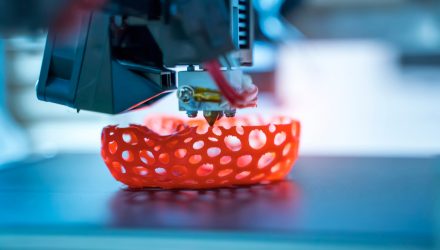Somewhat quietly, the 3D Printing ETF (CBOE: PRNT) is higher by 13.35% over the past month, but the lone 3D printing ETF’s recent surge isn’t a flash in the pan.
PRNT debuted nearly three years ago as the first US-listed ETF dedicated to the 3D printing theme. The fund is one of two passively managed products from New York-based Ark Investment Management. ARK believes 3D printing will revolutionize manufacturing by collapsing the time between design and production, reducing costs, and enabling greater design complexity, accuracy, and customization than traditional manufacturing.
The healthcare market continues looming as a major driver of long-term 3D printing growth, which could be a boon for PRNT.
“Factors such as growing focus on the advancement of medical products coupled with the rising importance of 3D printing in the healthcare industry are anticipated to contribute significantly towards the growth of the global 3D printing medical implants market,” according to Research and Markets. “Additionally, numerous benefits associated with 3D printing medical implants technology, increasing applications of 3D printing medical implants on the back of growing research and developments, increasing advancements in the healthcare industry coupled with the developments observed in orthopedics giving rise to the concepts of customized bone identical implant and CT-bone are some of the factors anticipated to drive the growth of the global 3D printing medical implants market.”
Healthcare Matters for PRNT
ARK believes 3D printing will revolutionize manufacturing by collapsing the time between design and production, reducing costs, and enabling greater design complexity, accuracy, and customization than traditional manufacturing. For its part, DoD has long used 3D printing.
“3D printing is a process in which a three-dimensional object is created by building consecutive layers of raw material,” notes Research and Markets. “The technology, which is aided by a digital 3D file, such as Magnetic Resonance Image (MRI) or a computer-aided design (CAD) drawing, plays an essential role in the healthcare industry as it provides healthcare specialists the power to manufacture several medical devices. The global 3D printing medical implants market is anticipated to achieve a CAGR of around 19% during the forecast period, i.e. 2019-2027.”
The medical implants market could be an epic growth frontier for some PRNT components going forward.
“The global 3D printing medical implants market consists of various segments that are segmented by component, implementation technology, application, end-user, and by region. The implementation of technology is further sub-divided into laser beam melting, electronic beam melting, droplet disposition, and others. Out of these, the laser beam melting segment held the largest market share of around 44% in the year 2018 and is anticipated to grow with a CAGR of around 21% over the forecast period and cross a value of around USD 2400 million by the end of 2027,” notes Research and Markets.
For more on disruptive technologies, visit our Disruptive Technology Channel.
The opinions and forecasts expressed herein are solely those of Tom Lydon, and may not actually come to pass. Information on this site should not be used or construed as an offer to sell, a solicitation of an offer to buy, or a recommendation for any product.

